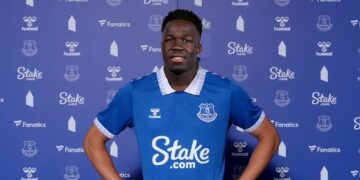Collared.
If you’ve tuned in to an NFL game recently, you may have noticed something interesting around the necks of NFL players. No, it’s not jewelry, but something that might be the new wave in head injury prevention: the Q-Collar.
The Q-Collar is the latest attempt in head injury prevention, but there’s more than a bit of controversy surrounding the use and implementation of it. Still, NFL players have taken to using the Q-Collar, with more and more players using the gear during games.
MORE: How does the NFL’s concussion protocol work?
Here’s what to know about the latest device:
What is a Q-Collar in football?
The Q-Collar is a small, lightweight necklace-type device to applies a small bit of pressure to the wearer’s internal jugular vein. Inside the plastic frame is a metal spring that keeps the collar in place.
The idea is to increase blood flow surrounding the brain, so when there’s impact, the blow is lessened, thus attempting to avoid concussions.
“This puts a kink on the hose, so the jugular is slower to drain,” Dr. Julian Bailes says. “This kink fills capillaries around the brain with just about a tablespoon of extra blood, stabilizing it almost like bubble wrap.”
NFL players wearing the Q-Collar
A number of NFL players have started sporting the Q-Collar in 2023, including:
- Chargers LB Drue Tranquill
- Cowboys RB Tony Pollard
- Cowboys TE Dalton Schultz
- Panthers LB Shaq Thompson
- Rams S Taylor Rapp
- Eagles RB Boston Scott
- Seahawks TE Colby Parkinson
In addition to NFL players, a number of athletes from other sports have also taken to utilizing the Q-Collar.
How does the Q-Collar work?
The collar puts a small bit of pressure on the jugular veins, slowing blood flow to vessels around the brain. Essentially, extra blood around the brain operates as almost some kind of pillow, to reduce head injuries.
Per the Q-Collar website:
Because the brain floats inside the skull, it moves — sometimes with great force — when the head is exposed to an impact. By applying light pressure to the sides of the neck, the Q-Collar increases blood volume in the brain’s venous structures, reducing the harmful internal movement that causes brain injury.
This claim, though, has been met with some skepticism from medical experts.
Why NFL players wear the collar around their neck
With the NFL’s concussion issues persisting through the years, players have made it a habit to try and use any new technology and gear to try and reduce the effects of brain injuries and concussions. The Q-Collar falls into that category.
This is nothing new, considering players have tried all sorts of things to try and alleviate concussion issues, from neck boards to oversized helmets.
MORE: Why Cowboys’ Ezekiel Elliott is wearing a futuristic helmet for 2022 NFL season
Does the Q-Collar really work?
Q30, the Q-Collar’s maker, sponsored a study of 284 high school football players in 2018. After a season, 77 percent of athletes who wore the Q-Collar reported no significant changes to the brain, while 73 percent of the athletes who didn’t wear the collar did. The FDA said that the link wasn’t “validated.”
While the device is FDA-approved, that doesn’t mean that there’s enough medical evidence to prove that the Q-Collar succeeds in its goal to limit head trauma. The FDA’s approval statement says as much: In 2021, the FDA said the “data does not demonstrate that the device can prevent concussion or serious head injury.”
The agency also says that “the Q-Collar has not been demonstrated to prevent long-term cognitive function deficits, and the ultimate impact on clinical outcomes has not been evaluated.”
Some experts also say that the theory of cushioning the brain makes sense, but could lead to other problems, including disallowing the brain to expand.
“The brain sits in an enclosed space within a hard skull, and thus has very little room to expand if put under additional pressure,” Adil Hussain, D.O. told ABC News in 2021.
All that’s to say, you can wear it, but it might not do much good. There’s simply not enough known yet.
Read the full article here























